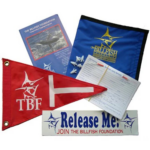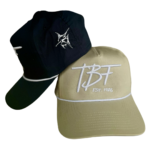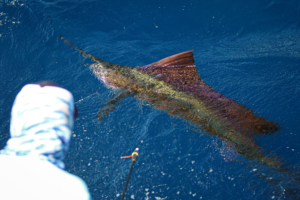
The Billfish Foundation maintains the largest private tag and release database in the world, with 260,000 records by 150,000 anglers. In 2020 alone, TBF anglers and captains tagged, released, or recaptured 7,000 billfish and tuna across the world. Of these 7,000 new records, 2,908 were of sailfish. Sailfish (Istiophorus platypterus/albicans) are native to the Atlantic, Pacific, and Indian Oceans. Istiophorus albicans refers to the Atlantic sailfish, while Istiophorus platypterus refers to the Indo-Pacific sailfish. However, many use Istiophorus platypterus for both, as there is little difference between the two aside from size and location. Here, The Billfish Foundation also combines the two.
Sailfish are some of the easiest billfish to identify, as they are the only species with their characteristic sail. Even still, information on how to identify a sailfish is available on our youtube channel. You can also click here for information on our Tag and Release Program and here to purchase tagging equipment and other TBF items.
Tags
TBF Captains and anglers tagged a total of 1,357 sailfish in 2020. On average, sailfish were fairly small, weighing 46lbs (20.9kg) and measuring 66.5in (167cm). However, the largest was 250lbs (113.4kg) and the smallest was a tiny 8lb (3.6kg) juvenile. Most tagged sailfish were in the Caribbean Atlantic and measured below 100lbs (45.4kg).
A remarkable 438 anglers and 116 captains tagged sailfish in 2020. The majority of these were in North America, but sailfish were tagged out of almost every continent. The most prolific Captains were Ben Horning, Bobby McGuinness, Mark Pagano, Mike Hunter, Patrick Price, Stephen Brexel, and Bomber Farrell. Outstanding anglers include Laura and Chris Jessen, Christian Hampl, Jill and Scott Yates, and Jacob Lepera.
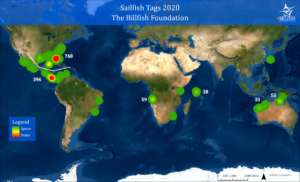
Most tagged sailfish were in the North Atlantic around the Caribbean. Florida puts up a massive sailfish tagging effort and is responsible for the deep red hot spot of tagging in the map above. Also significant is the tagging effort of Costa Rica, our second highest contributing country, as can also be seen above. Worth noting, also, were the countries of Angola and Australia, specifically Luanda, Angola and Groote Eylandt, Australia. Both of these locations consistently exhibit a strong dedication to sailfish tagging. Worldwide, sailfish were tagged out of the USA, Costa Rica, Mexico, Australia, Papua New Guinea, Panama, Guatemala, Brazil, Seychelles, South Africa, Kenya, and Angola.
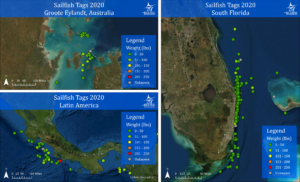
In the Northern Hemisphere, sailfish season is in the early months of the year. Thus, it is no surprise that the highest proportion of sailfish tags were from January to May. The trend seen below is similar to years past, as it is typical for sailfish tagging to dip in the summer and not begin to rise until the beginning of the following year. However, typically sailfish tagging stays much higher in March and April. The large dip from February to March is possibly due to the quarantine measures required in the beginning COVID-19.
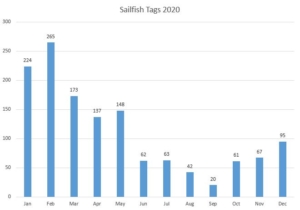
Releases
2020 saw more sailfish releases than tags. A total of 1,511 sailfish were released without tags in 2020. Almost all sailfish releases occurred in North America. However, where tags were higher on the Atlantic side of North America versus the Pacific side, releases are nearly equal between the two oceans. This is mostly due to the massive number of releases in Costa Rica and Guatemala.
Also starkly different from sailfish tags is the number of Captains and anglers involved in sailfish releases in 2020. 153 anglers released sailfish in 2020, roughly a third of the number that tagged. Similarly, 54 Captains released sailfish, less than half of those that tagged. However, the most prolific were similar to sailfish tags. The highest numbers were from anglers Scott and Jill Yates and Gray Ingram, along with Captains Jason Brice, Mark Pagano, and Dean Panos.
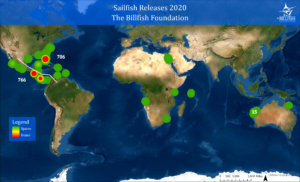
Sailfish releases and tags exhibited similar temporal trends. This is expected, given that they were both mostly concentrated in North America. The primary difference is simply in the severity of the trend. Like tags, sailfish releases peak in the first months of the year. However, the drop-off from March to April is substantially greater, with less than 100 releases per month for the entire rest of the year.

Recaptures
An incredible 40 sailfish recaptures occurred in 2020. Sailfish are typically our most recaptured species due to the high effort in South Florida, and 2020 was no different. In fact, South Florida had so many that we had to separate their maps based on time at large! Nine sailfish were recaptured after less than one year at large versus seven between one and two years, seven between two and three years, and two at large for over three years. Almost all South Florida sailfish stayed in South Florida except for one which migrated further South to Cuba.
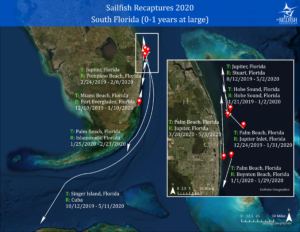
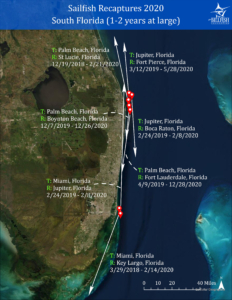
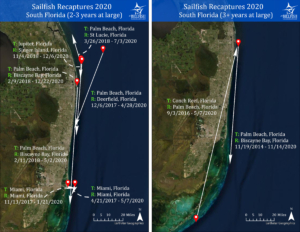
However, South Florida cannot take credit for all of the recaptures. Five recaptures occurred outside of Florida. Of these, only one, in Mexico, occurred in the Caribbean/Atlantic. The remaining four were based in the Pacific – one in Costa Rica and four in Groote Eylandt, Australia. For many years, Captains and anglers in Groote Eylandt have exhibited impressive tagging effort. As a result, it has become fairly common for them to recapture their own fish!
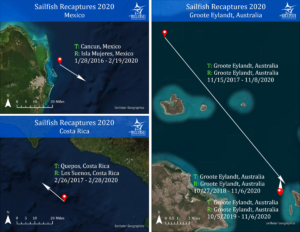
Thank you to all of the captains, mates, and anglers that tagged and released sailfish in 2020. To stay up-to-date with all things billfish, become a member, subscribe to our newsletter, visit our online shop, and follow us on social media, @TheBillfishFoundation.
*Please note that this review contains only data that was recorded between January 1, 2020 and December 31, 2020 and received by TBF by February 30th, 2021

